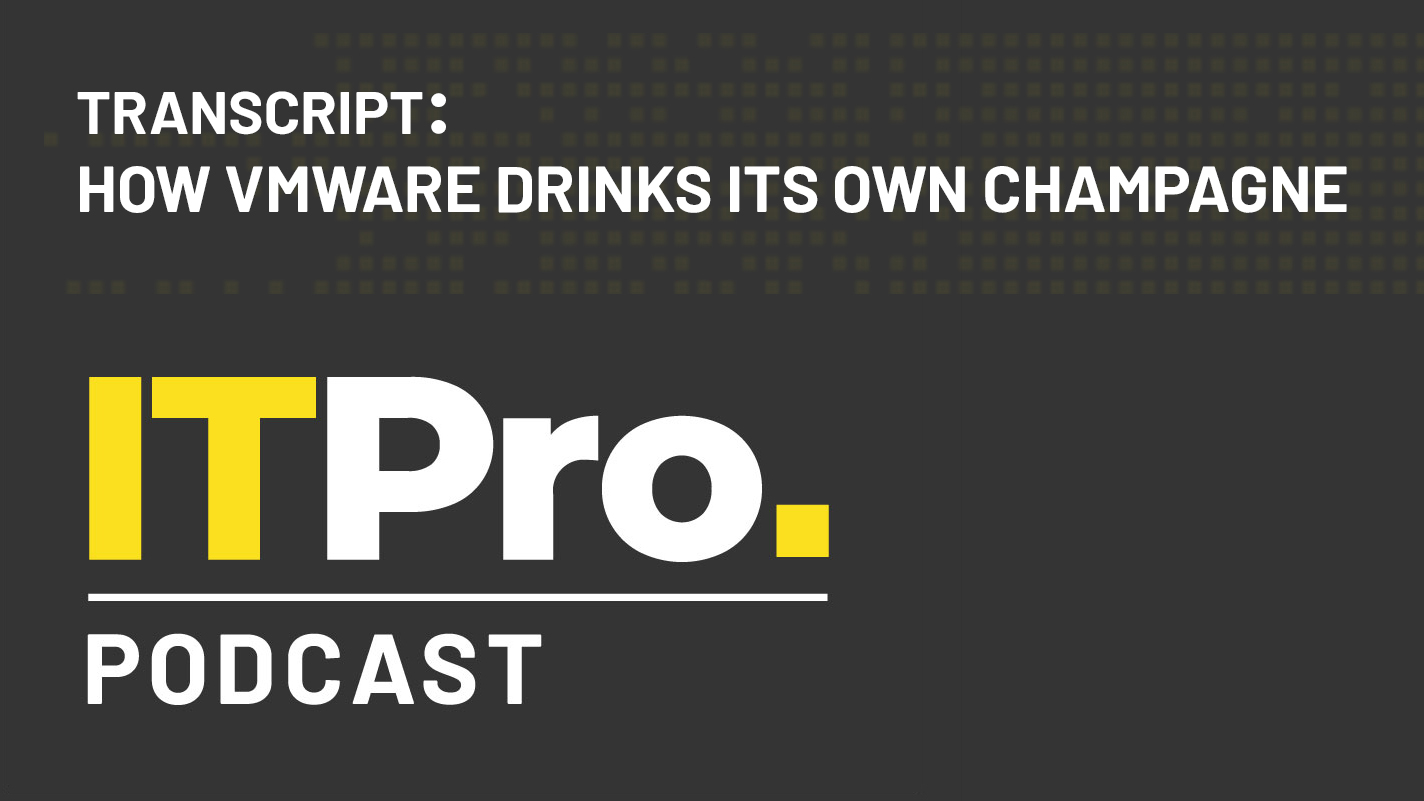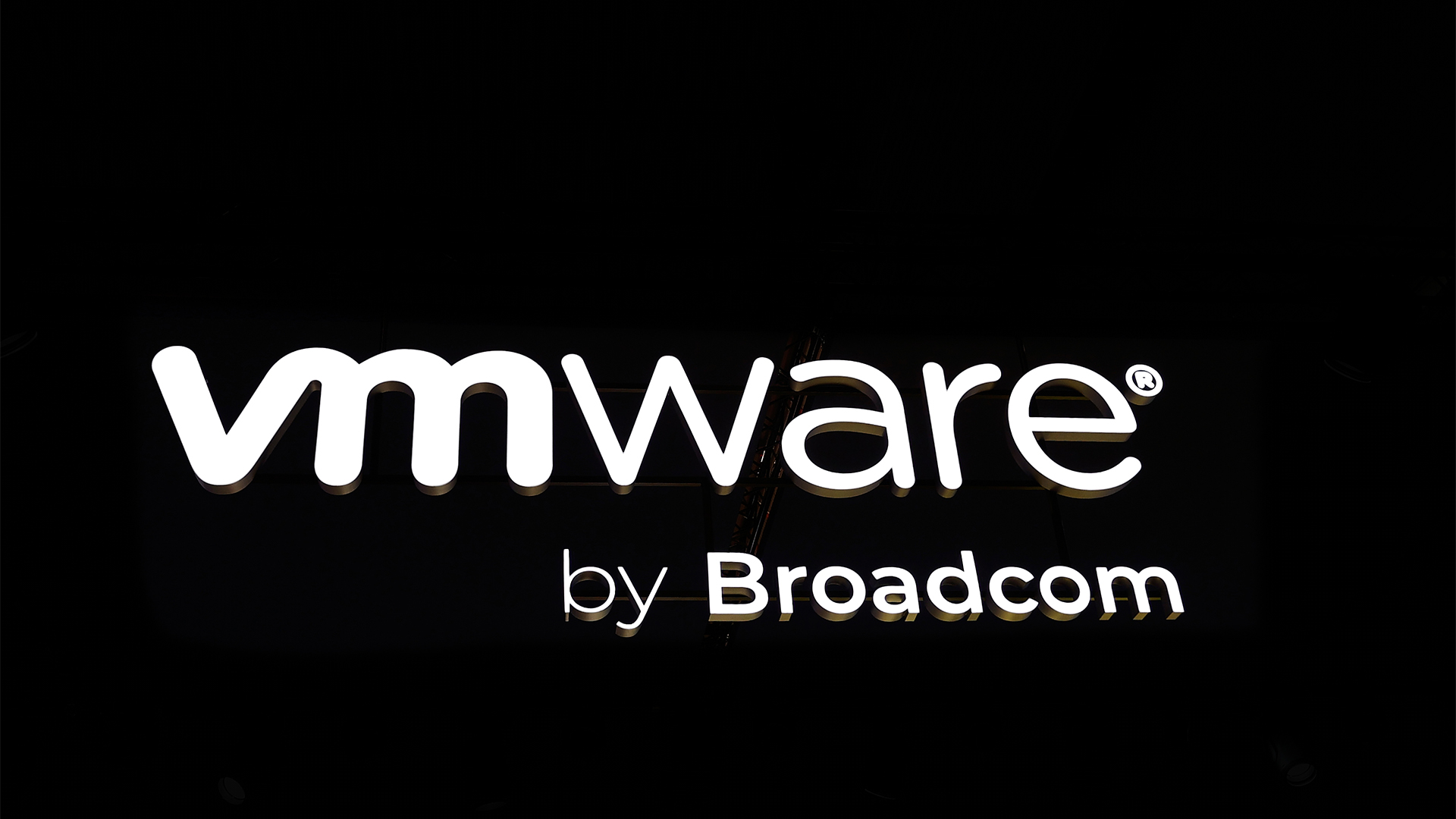
This automatically-generated transcript is taken from the IT Pro Podcast episode ‘How VMware drinks its own champagne’. To listen to the full episode, click here. We apologise for any errors.
Adam Shepherd
Hi, I'm Adam Shepherd.
Jane McCallion
And I'm Jane McCallion.
Adam
And you're listening to the IT Pro Podcast.
Jane
It's said that the customer always comes first; a saying that you're likely familiar with, even if you're not steeped in sales and marketing where the slogan originated. And while it's true that paying customers should be treated with respect and attentiveness, it's important not to forget about your internal customers, people within the business who rely on you to do their jobs. For IT departments, that customer base stretches the length and breadth of their organisation.
Adam
This week, we're looking at what it's like managing the internal toolsets of an IT giant - VMware. We're joined by Jason Conyard, the company's global CIO, to discuss some of the technology used by VMware's internal customers, and how the company's own use of IT informs its product roadmap. Jason, thanks for joining us.
Jason Conyard
Not at all, It's wonderful to be with you both.
Sign up today and you will receive a free copy of our Future Focus 2025 report - the leading guidance on AI, cybersecurity and other IT challenges as per 700+ senior executives
Jane
As global CIO, is your role mainly focused on VMware's employees or its customers?
Jason
I don't actually differentiate, it's actually an interesting question that comes up a lot. When I'm talking to people and they refer to employees inside of the company as customers, I make a conscious choice of not doing that. In fact, we very specifically refer to everybody inside of the company as our colleagues, because we don't believe that IT is distinct from the business, we think that it is part of the business, a fundamental and critical part of the business. And a company like VMware, that is a technology company, we're also, we also call ourselves customer number zero, because we are using our own products all the time, we're providing feedback to our product teams all the time. So we really don't differentiate.
Adam
So looking at the tools that VMware's internal teams and internal IT departments use, obviously, you'll be using VMware Tools for things like desktop and app virtualization. But aside from VMware products, what are some of the most crucial components of your IT toolkit?
Jason
I think one of the amazing things about technology companies is that they often have just about every flavour of everything that's ever been created. And when you, when you take a company, like VMware, which is particularly innovative, and creative, in fact, we pride ourselves on being innovative and creative, we really try and make sure our colleagues have access to a rich and diverse spectrum of tools. That is empowering for them. It can also be incredibly challenging from a technology management perspective. So all of the things that you would expect any development team to have. So Slack, of course, is widely used across the company. But equally, you could pick just about any other collaboration tool available on the planet, and find at least some instance of it being used in the company.
Adam
Does that not raise problems from a shadow IT perspective in terms of keeping track of what tools are in your environment? What the kind of permissions and integrations are around those?
Jason
Yeah, I think of my role a little differently. I don't think of myself as being distinct and separate from the other technologies that are used in other parts of the company. I think of my role as being the custodian for the whole company when it comes to technology. So So I understand how some teams may say oh, that something is shadow IT, because it is technology selected or managed outside of the IT department. But But I still see that as my responsibility. I'm ultimately, there's no caveat or asterisk next to something that says, oh, you're the CIO and accountable for our data, data, or you're accountable for our systems - except for anything, you didn't pick. No. The board, the board doesn't think of it that way. They're like, well, you're the CIO, you're responsible. So I do, I do think it drives important conversations, especially when we talk about how we optimise our efficiency. And that is yes, that has a cost dimension to it. But more often than not, I'm less focused on the cost element. And I'm far more concerned about the friction that having multiple tools may introduce. So as an example, if you've got people using different collaboration tools, it can be difficult for them to work together. Could you imagine having the cellular companies or the mobile companies in the UK have a situation where you're on one provider and Jane's on another provider, and you couldn't call each other - that that will be untenable. And you would, it would last about three minutes right before you found a solution. And yet that is absolutely the situation we see across collaboration tools in the industry. So again, when I look at different technologies, and I see different technology choices being made, I'm more focused on what friction does that introduce? What inefficiency does that create in the environment? And yes, of course, of course, what compliance considerations and governance considerations are there?
Jane
I'd be interested to dig into that a little bit more, because how do you sort of deal with management of such a broad set of tools that are in use, whether you gave it sign off, or whether somebody just went off and did it? And how do you, I guess, encourage people to be honest, if they've brought a new service into the company like, Oh, actually, my little team has just started using Zoom. I mean, who heard of that before the before the pandemic? Now, it's like kind of the go to for talking about video conferencing. How do you deal with all of that?
Jason
So so one of the important things about the company, and one of the reasons, honestly, why I joined and why I've stayed is the culture, the culture of VMware is... one of the things I would say is that every company I've worked for in my career has had a set of values. And you know, when when when people were in offices, you'd walk into the kitchen area where and there was probably a poster on the wall that reminded people of their values, there's probably some sticker on their company badge that says what the values were, and so on, and so on. One of the things that really appealed to me about VMware is that we really live those values, they are taken very, very, very seriously, they are deeply ingrained in who we are. An important part of that is the trust that we engender in our colleagues. And we want people to do the right thing, because they understand the reasons behind it rather than just doing something because they've been told to do it. Now. Is that perfect? No, of course, it isn't. People are involved. But but but it's an important starting place. And of course, after that, we have things that we have processes, such as our architecture review board, where we will look at technologies that we are going to employ in the environment. And then of course, we have other controls, we have security controls and other things. So if somebody suddenly wanted to fire up a version of, you know, a new SaaS product - I'm not going to name one - but if somebody was to fire up a new version of a SaaS product and suddenly wanted to, you know, put customer data or company data in that environment, we would know about it very, very quickly. And we would approach it from the perspective of, I'm sure you were trying to do the right thing, I'm sure you didn't realise that there were these considerations. So let's help you right now ensure we're protecting the company and our obligations, and then make sure we're helping you achieve the outcomes you're looking for.
Jane
That special kind of data protection alarm goes off when somebody tries to do that.
Adam
So with that in mind, do you think it's fair to say that your main focus is on interoperability of tools and systems?
Jason
I would say that... well, actually you know what, let me just share with you what the mission statement is for our colleague support team, because I think it says, it says a lot. So in many companies, they have some sort of IT support function, right? That's a help desk or something of that nature, right. And, sadly, in many companies, those teams are grossly under appreciated. And often an area that a company would look to drive efficiency in, which it often marvels me, because it's an area of, of less cost, not high cost. And if I was going to go after savings, I would probably focus on high-cost things. But one of the things that I think I've I've really focused on as a leader, actually, in my time before being CIO at VMware, when I was responsible for, for our colleague experience and technology team was, was making sure that we thought about that function and gave it the credit that I've always believed it deserves. And that team's mission is to enable our colleagues to do their best work by delivering a delightful technology experience. And I want to emphasise that point, because I think that actually, that is part of the DNA of the IT team. It is about how do we enable our colleagues? How do we enable the business? And how do we truly want to deliver the technology with the opposite emotion that people normally associate with technology, which is frustration. I know, I know, when I first had these conversations with the team, there were definitely some eye roles and a few comments about that's very Mary Poppins of Jason, you know, a delightful technology experience. But but it didn't take too long before folks realised that I was deeply serious about that. So back to your question. Is it is it about you know, optimising those things and interoperability? That is part of it, but that that is towards an outcome and that outcome is enabling our colleagues to to do their best work and do their best work in the service, ultimately, of our customers. And I think that's something that we all take deeply seriously.
Jane
And so are there any learnings that you've taken from VMware's own use of IT, you know, kind of how you adopt it, what you've been adopting, how you implement it, and fed it into the company's product development at all?
Jason
It's the reason why I'm at the company. I remember, I remember having a beer with the now former CIO of VMware, Bask Iyer, who, who I've worked with elsewhere, and is a very good friend of mine. And Bask and I were having a conversation about me joining VMware, we were talking about the opportunities and he, he knows me well, and he said, I've heard you be frustrated with some of the products. And this is to be clear, this is like six years ago, I've heard you be frustrated with some of the products the company has in the past, being a customer of those products. So why don't you put your effort where your mouth is, and come and help do something about it. And, you know, I can't resist a challenge. So so so when I joined the company, again, you know, six years ago, now when I joined the company, one of the things that he really wanted me to do was engage very closely with the EUC, the end user computing product organisation, who's responsible for things like you know, our, our 'anywhere workplace' products, such as, you know, Horizon View, and Workspace One and some of those other tools. And really help them understand the experience of the customer, not not understand a specific feature, necessarily, although that definitely became part of the conversation. But really understand the experience of the customer, help the product team walk in the shoes of a customer, and really start solving the problems the customer had, rather than than necessarily solely creating intellectually interesting solutions. And that's very important, because you can have very smart people who think they know what the need is, or create very interesting solutions, but they may be more academic in nature rather than actually outcome based. And that was an area of conversation that my team got deeply involved in. Now, if I fast forward to today, so tell you the state of play today. The IT team is involved in not only providing direct feedback to the product team, and I don't mean once a month or once a year or, you know, when there's a problem. The IT team have direct access to add bugs and feature requests to our product divisions. Not Not Not a one off thing. This is ongoing. If we have either a new capability we're trying to deliver as a company or any specific need or problem we're trying to solve, my team will sit virtually or physically next to the development team for as long as it takes which in one case, I won't be specific which one, but in one case was more than a year.
Adam
Oh, wow.
Jason
And and yes, we absolutely use our own products. But my rule is always we'll use our own products when it meets a need we have and it ticks the boxes that we have, and not before. And then the product team - and I think that's important and critical feedback for the product team because it forces an honest conversation, because if something was to be escalated, you could imagine, imagine someone said, Hey, you know, IT refuses to run, we're going to escalate to Ragu. This is hypothetical, this isn't real. But if they were to escalate to the CEO of the company, if you were the product manager, and you weren't taking the requirement seriously, would you really want to be in front of the CEO of the company having having to defend that? You wouldn't, right? So So now the good news is, that's not the nature of the dialogue, the relationship has come such a long way now, it really is a trusted, a deeply trusted relationship. I'll say one more thing about this, that may surprise you is that we really try and cultivate a culture of innovation and creativity across the whole company. And that includes in our IT and our technology organisations. So much so that this year alone, the IT team has filed for seven patents, the IT team has filed for seven patents. So there is a deep level of trust and engagement there. It's not just about making email work. It should be about better outcomes.
Jane
Although, that's never a bad thing.
Adam
No.
Jason
That That to me, though, is table stakes. You get to, you get a seat at the table because that stuff works. Whether you get to stay at the table is how much more you contribute over and above that.
Adam
I think it's particularly interesting, what you mentioned about not using VMware products until they meet a specific need and meet a specific challenge. I think there's there's quite often in, particularly in big enterprise tech companies, there is a kind of common company line that everyone uses the company's tools, you know, in in some cases, regardless of whether or not they're necessarily the best fit. And I think that's a very encouraging attitude to take in terms of internal tooling.
Jason
Yeah, I think that it's, it's very simply based on the fact that we want to deliver the very best thing to our customers. And we that means we need to be able to do that for ourselves first, it doesn't mean blindly doing something because you've been told it means intellectually, creatively, constructively respectfully, challenging each other to do better.
Jane
Yeah, you don't want like your colleagues coming back to you, if you give them something that's half-baked but to a deadline and coming back to you with basically, what is this, here re 10,000 bug reports.
Jason
We want to be, we want to be proud of what we deliver.
Adam
And of course, I would imagine that the the proportion of the business that isn't using a particular tool can in some cases tell you as much as the departments within the business that are using it, you know, why does this specific tool or function not meet the needs that you have? What are you using instead of this to meet those needs? What learnings can we take from that? How can we start to kind of shape the roadmap and integrate those, those elements to have it meet those needs?
Jason
Yeah, absolutely. And not every solution that we deliver as a company would necessarily be viewed as a solution for IT inside of VMware, there are solutions we deliver that may be more relevant to the carrier market as an example. Or they may be more relevant to user communities that are work of, work from home, which right now just happens to be 95% of the company. But in different times, might only represent maybe a third or half of the company. So yeah, and that feedback is, as you say, is is maybe as valuable as the feature set.
Jane
So how important is the early adoption of new tools and technologies within VMware's internal IT organisation?
Jason
Very important, but it's about the when. So we wouldn't, we wouldn't consider something to be ready for our customers if we didn't think it was ready for use inside of the company. So we would absolutely, you know, we would absolutely trial things. The other thing I would say is that, you know, we have ever expanding test environments as we would for the rollout of a new operating system or a new application that can be equally and is equally applied to our own solutions. So you know, we might, let's take some of our cloud solutions as an example, we might roll them out and host certain non business critical things on them early on, to identify and shake out bugs or nuances that hadn't previously been identified, that would be completely reasonable for us to do. Now, would we, would we employ that in the whole of the company until we've baked things out? No, we wouldn't, because I'm running, you know, running the services for a very large company with a lot of customer obligations and responsibilities. So it's, it's a thoughtful and considered process. And thoughtful and considered doesn't mean slow. And I think that sometimes people think it means... no, it doesn't. The company's agile and dynamic and we move very, very quickly. But we also do it in a thoughtful way.
Adam
Like the opposite of move fast and break things.
Jason
Indeed! Well look, there, there is a time and place to do that. And and there's absolutely instances where where we do that, but we would we would define them well. We would say, you know, it's okay to fail here. It's okay to break things here. But we're not going to do that if it impacts our financial systems or support of and enablement of our customers.
Adam
So speaking of new tools, and early adoption, does AI play much of a role within your IT estate at the moment?
Jason
Yeah, so a growing role. In fact, like any new burgeoning technology, we tend to create, a burgeoning technology that has a lot of interest across the company, we tend to create a centre of excellence and that doesn't necessarily mean a hierarchical organisational structure, it can just as easily be a virtual structure, more kind of a birds of a feather or Community of Practice consideration, where maybe you know, we'll pull together people that are very interested or engaged around AI or ML, and have them work together. Another example actually, some of our work around virtual reality and augmented reality. We've done some similar things in that space where we, we saw interests across many different product groups, we saw potential for those technologies. And rather than having everybody go off and reinvent the wheel, we kind of had those people loop together a little bit more, a little more formally, to kind of share their learnings and share the potential. The other amazing thing about doing something like that, as well is you really start to see people bounce ideas off each other. And when, when egos are not in the way you can really accelerate the speed at which you see potential. So how we might leverage AI as an example, and ML to better shape the nature of our products. Maybe it's around how the user interface in something is designed, maybe it's around, you know, the capability or the process steps that a customer might follow to build certain services in the cloud. So that then allows us to accelerate how we can deliver a solution or help our customers deliver their solutions to their business. But that was that was definitely true, as I mentioned, around the augmented and virtual reality space, we did some particularly, or have been and are doing some particularly interesting things there too.
Adam
Yeah, that's particularly interesting. VMware wouldn't be the first company that that springs to mind when I think of kind of VR and AR applications. Can you share some more information on the kind of stuff you're doing in that area?
Jason
So I'm going to say that everything I'm going to talk about is non product related. So just, I want to be careful about that. That doesn't mean to say there, doesn't mean to say there aren't product potentials or opportunities on the horizon, but I'm going to focus on our internal use of these technologies. So a couple of years ago, we really started to think about how can we span time and space and bring the people together to co-create? How can we bring people together in a matter of seconds in a very rich, immersive experience that doesn't require someone to fly 8,000 miles? So that was kind of a team view of things, you know, because you're bringing people together. Another example is also how do we create moments for people to focus and concentrate, but have resources at their fingertips, which don't require someone to physically visit a data centre or a lab. So there are two very distinct examples, there are actually many more, but there are two very distinct examples of a deep work type scenario, versus a collaborative engaged type scenario. And we've been experimenting with that a while and we really wanted to think about how could this technology be applied? But also, what were some of the limitations of the technology at the time and of course, this is a rapidly moving space now. And I think we'll see some consumer solutions in this, or more consumer related solutions in this area soon. But I think what's really interesting is to think about what are the challenges so as an example, if you're in virtual reality, I'm sure you've you've done this, and some of your audience will have done this as well, trying to type in your username and password and trying to type in general, right, it's a pain in the butt, right? So, so now imagine that actually, that gets integrated with something like workspace one. So you've got Single Sign On, and you've got access to all your applications at your fingertips. And that can involve a traditional application being rendered in a 2D space in 3D, as well as creating a new experience in 3D in a 3D space. So there are things like that as an example that we've been trying to work on. The other thing we've been trying to do as well, and this is much more in the kind of deep work space is how we can bring new senses to bear. So we think of virtual reality from from an audio and visual perspective. You wouldn't normally think about smell, right?
Adam
Not generally...
Jason
Now, but but we all know that smell really drives our emotions, and is incredibly provocative when it comes to memory. And that's an area that my team has been playing with as well, which is how do we create - I'm being serious now - How do we create smells in virtual reality so that we can help people reach that mental state? Whether it's a state of excitement, or exhilaration, or deep relaxation. How do we how do we create smells in a space that help people connect to the visual cues that they're getting? So as an example, using something from home, if we were, if we were going to have a team meeting, and it might be you know, I might be in California, or you may be in the UK, but we've decided that we're going to meet in the Muir Woods, which is a beautiful redwood grove on the coast of Northern California. We could do that. And yes, sure, we could create the sound and we create the sights, but by adding that smell of the redwoods as well, really creates a much deeper connection to the people and allows you to reach that common state of mind at the same time. All of these things I think, are going to be incredibly important especially as we move to the future of work. And we recognise the potential of people working in a more hybrid work model.
Jane
I'd never imagined that you might need to combine VR or AR with some kind of smart diffuser and essential oils, bringing together kind of like quite the hippy kind of stuff with extreme kind of cutting edge technology.
Jason
Yeah, and the truth is, you know, as I'm sure you know, right, this has been happening in in retail for a really, really long time. It's quite common for retail outlets to have their own fragrances and sometimes even more than one, that, you know, help create an emotional connection with people and the product.
Jane
Yeah, the fresh baked bread in supermarkets I think is a very good classic. Yeah.
Adam
Yeah. And all of those concerns around VR and using it for remote working is something that we've heard from a few companies over the pandemic. We spoke to Remote.com's director of people, Nadia Vatalidis earlier in the year about how they're doing that exact thing using VR headsets to bring people together for collaboration across kind of vast distances, which is kind of a really, a really interesting use case, although they weren't quite at the level of smell-o-vision just yet.
Jason
Yeah, it's I think, I think these are all you know, it's definitely a futures thing. But I don't think it's distant future.
Adam
So Jason, there's a saying that comes up quite a lot, particularly in tech and software development around eating your own dog food. Now, for any business, customer facing projects and technologies are often made a firm priority. But how important would you say it is to, quote unquote, eat your own dog food and get the internal tooling right, before you move on to customer facing projects and tools?
Jason
I think drinking your own champagne is critically important.
Adam
It's a much classier version.
Jason
Yeah. I think that if you are truly committed to your customers, if you really believe in your craft, you want the very best outcomes. And to do that, with any level of success, you have to walk in your customer's shoes. And we we do that every day at VMware, we do it thoughtfully. We do it, you know, in consideration of all the dependencies and responsibilities we have for the company, but we believe we need to do it before our customers have to do it.
Jane
Well, unfortunately, that's all we have time for this week. But thank you once again to VMware CIO Jason Conyard for joining us.
Jason
It was a pleasure to be with you. Thank you.
Adam
You can find links to all of the topics we've spoken about today in the show notes, and even more on our website, itpro.co.uk
Jane
You can also follow us on Twitter where we are at @ITPro, as well as Facebook, LinkedIn, and YouTube.
Adam
Don't forget to subscribe to the IT Pro Podcast wherever you find podcasts to never miss an episode. And if you're enjoying the show, leave us a rating and a review. We'll be back next week with more analysis from the world of It. But until then, goodbye.
Jane
Bye.
ITPro is a global business technology website providing the latest news, analysis, and business insight for IT decision-makers. Whether it's cyber security, cloud computing, IT infrastructure, or business strategy, we aim to equip leaders with the data they need to make informed IT investments.
For regular updates delivered to your inbox and social feeds, be sure to sign up to our daily newsletter and follow on us LinkedIn and Twitter.
-
 CISPE claims European Commission gave Broadcom a ‘blank cheque to raise prices, lock-in, and squeeze customers’ with VMware deal
CISPE claims European Commission gave Broadcom a ‘blank cheque to raise prices, lock-in, and squeeze customers’ with VMware dealNews Cloud providers have issued a formal response to the General Court of the European Union after the Commission defended its approval of the deal
-
 Channel focus: All you need to know about VMware's partner program
Channel focus: All you need to know about VMware's partner programChannel Focus Parent company continues to choose a fresh direction in a bid to increase partner capabilities and value to customers
-
 Computacenter enters the fray against Broadcom in Tesco's VMware lawsuit
Computacenter enters the fray against Broadcom in Tesco's VMware lawsuitNews The IT reseller has added its own claim against Broadcom in VMware case brought by Tesco
-
 Tesco is taking Broadcom to court – here’s why
Tesco is taking Broadcom to court – here’s whyNews The retailer is demanding £100 million in compensation following VMware pricing and licensing changes
-
 How simplicity benefits the IT partner ecosystem
How simplicity benefits the IT partner ecosystemSponsored Content Across private cloud and AI adoption, simple approaches can unlock more time and money for IT teams
-
 A focused shift to partner-delivered services generates new opportunities with Broadcom
A focused shift to partner-delivered services generates new opportunities with BroadcomSponsored Content Broadcom is investing in professional services — delivered through partners — for long-term customer success
-
 VCF: The key to cloud success now and in the future
VCF: The key to cloud success now and in the futureSponsored Content Private cloud offers the security and scalability that modern enterprises require
-
 Moving Broadcom VMware licenses to subscription-based models
Moving Broadcom VMware licenses to subscription-based modelsSponsored Content With a committed channel, Broadcom makes the journey to subscription-based VMware licenses as smooth as possible



